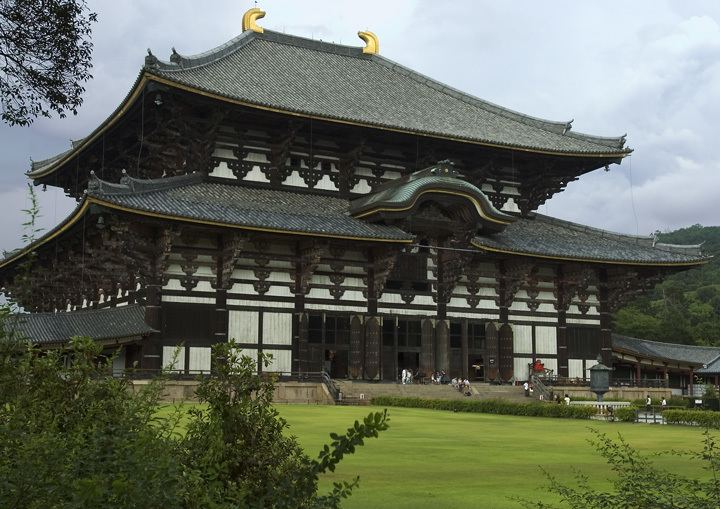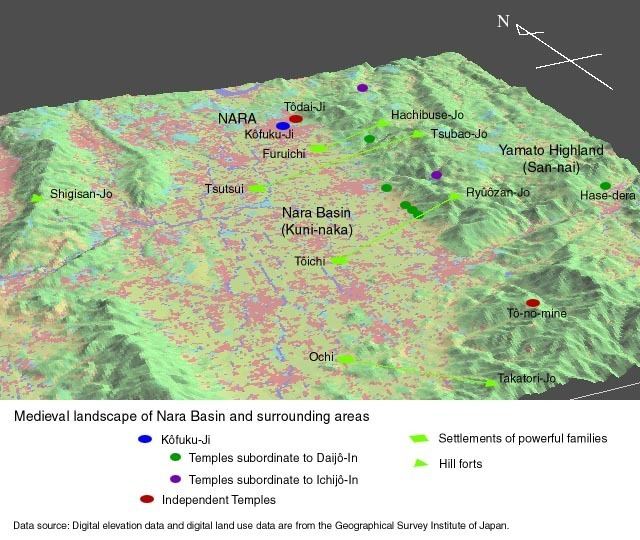Country Japan Area 276.84 km2 Mayor Gen Nakagawa | Population 366,591 (2010) Region Kansai | |
 | ||
Points of interest Todai-ji, Kofuku-ji, Kasuga-taisha, Toshodai-ji, Yakushi-ji Colleges and Universities Nara Womens University, Nara University of Education, Nara University, Tezukayama University, Nara Prefectural University | ||
Map of Nara, Nara
Nara (奈良市, Nara-shi, [náꜜrà]) is the capital city of Nara Prefecture located in the Kansai region of Japan. The city occupies the northern part of Nara Prefecture, bordering Kyoto Prefecture. Eight temples, shrines and ruins in Nara remain: specifically Tōdai-ji, Kōfuku-ji, Kasuga Shrine, Gangō-ji, Yakushi-ji, Tōshōdai-ji, and the Heijō Palace, together with Kasugayama Primeval Forest, collectively form "Historic Monuments of Ancient Nara", a UNESCO World Heritage Site.
Contents
- Map of Nara Nara
- Osaka 2014 a visit to nara
- Nara japan joe journeys
- Etymology
- History
- Modern Nara
- Geography
- Climate
- Demographics
- Landmarks
- Deer in Nara
- Education
- Universities
- Public schools
- Private schools
- Transportation
- Rail
- Roads
- Twin townssister cities
- In Japan
- Outside Japan
- References

Osaka 2014 a visit to nara
Nara japan joe journeys
Etymology

By the Heian period, a variety of different characters had been used to represent the name Nara: 乃楽, 乃羅, 平, 平城, 名良, 奈良, 奈羅, 常, 那良, 那楽, 那羅, 楢, 諾良, 諾楽, 寧, 寧楽 and 儺羅.

A number of theories for the origin of the name Nara have been proposed, and some of the better-known ones are listed here. The second theory in the list, by notable folklorist Kunio Yanagita (1875-1962), is most widely accepted at present.
The "Flat land" theory is adopted by Nihon Kokugo Daijiten (the largest dictionary of Japanese language), various dictionaries for place names, history books on Nara and the like today, and it is regarded as the most likely.
History
Nara was the capital of Japan from 710 to 794, lending its name to the Nara period.
The temples of Nara, known collectively as the Nanto Shichi Daiji, remained spiritually significant even beyond the move of the political capital to Heian-kyō in 794, thus giving Nara a synonym of Nanto (南都, "The southern Capital").
In 2010, Nara celebrated the 1,300th anniversary of its ascension as Japan's imperial capital.
Modern Nara
In the modern age, as the seat of the prefectural government, Nara has developed into a local center of commerce and government. The city was officially incorporated on February 1, 1898.
Geography
The city of Nara lies in the north end of Nara Prefecture, directly bordering itself to Kyoto Prefecture in its north side. The city is 22.22 kilometres (13.81 mi) from North to South, from East to West. As a result of the latest merger, effective April 1, 2005, that combined the villages of Tsuge and Tsukigase with the city of Nara, the city now borders Mie Prefecture directly to its east. The total area is 276.84 square kilometres (106.89 square miles).
The downtown of Nara is on the east side of the ancient Heijō Palace site, occupying the northern part of what was called the Gekyō (外京), literally the outer capital area. Many of the public offices (e.g. the Municipal office, the Nara Prefectural government, the Nara Police headquarters, etc.) are located on Nijō-ōji (二条大路), while Nara branch offices of major nationwide banks are on Sanjō-ōji (三条大路), with both avenues running east-west.
The highest point in the city is at the peak of Kaigahira-yama at an altitude of 822.0 m (2,696.85 ft) (Tsugehayama-cho district), and the lowest is in Ikeda-cho district, with an altitude of 56.4 m (185.04 ft).
Climate
The climate of Nara Prefecture is generally temperate, although there are notable differences between the north-western basin area and the rest of the prefecture which is more mountainous.
The basin area climate has an inland characteristic, as represented in the higher daily temperature variance, and the difference between summer and winter temperatures. Winter temperatures average approximately 3 to 5 °C (37 to 41 °F), and from 25 to 28 °C (77 to 82 °F) in the summer with highest readings reaching close to 35 °C (95 °F). There has not been a single year since 1990 with more than 10 days of snowfall recorded by Nara Local Meteorological Observatory.
The climate in the rest of the prefecture is that of higher elevations especially in the south, with −5 °C (23 °F) being the extreme minimum in winter. Heavy rainfall is often observed in summer. The annual accumulated rainfall totals as much as 3,000 to 5,000 mm (118.11 to 196.85 in), which is among the heaviest in Japan and indeed in the world outside the equatorial zone.
Spring and fall temperatures are temperate and comfortable. The mountainous region of Yoshino has been long popular for viewing cherry blossoms in the spring. In autumn, the southern mountains are also a popular destination for viewing fall foliage.
Demographics
As of 1 April 2017, the city has an estimated population of 359,666 and a population density of 1,300 persons per km2. There were 160,242 households residing in Nara. The highest concentration of both households and population, respectively about 46,000 and 125,000, is found along the newer bedtown districts, along the Kintetsu line connecting to Osaka.
There were about 3,000 registered foreigners in the city, of which Koreans and Chinese are the two largest groups with about 1,200 and 800 people respectively.
Landmarks
Deer in Nara
According to the legendary history of Kasuga Shrine, the god Takemikazuchi arrived in Nara on a white deer to guard the newly built capital of Heijō-kyō. Since then the deer have been regarded as heavenly animals, protecting the city and the country.
Tame sika deer (also known as spotted deer or Japanese deer) roam through the town, especially in Nara Park. In 2015 there were more than 1,200 sika deer in Nara. Snack vendors sell sika senbei (deer crackers) to visitors so they can feed the deer. Some deer have learned to bow to people after receiving senbei.
Education
As of 2005, there are 16 high schools and 6 universities located in the city of Nara.
Universities
Nara Women's University is one of only two national women's universities in Japan. Nara Institute of Sciene & Technology
Public schools
Public elementary and junior high schools are operated by the city of Nara.
Public high schools are operated by the Nara Prefecture.
Private schools
Private high schools in Nara include the Tōdaiji Gakuen, a private school founded by the temple in 1926.
Transportation
The main central station of Nara is Kintetsu Nara Station.
Rail
Roads
Twin towns/sister cities
Nara, according to its own official record, has three sister cities in Japan and six sister cities overseas.
